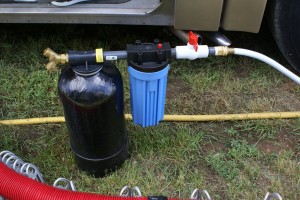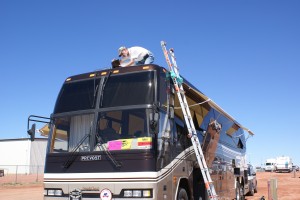We knew we would be changing RV parks within the CAM-PLEX this morning, so right after breakfast I dealt with sewer, water, and electric hookups while Linda secured the inside for our short but potentially bumpy trip. Bob Pinner came by around 8:00 AM to check on us, and came back around 8:30 AM to lead us to the appropriate area in Boxelder RV Park. We had our choice of spots and picked one that was level and dry, indicating relatively good drainage, with a good stretch of road in front of it. We chose site D-67 and pulled through into the site from the west so we would be parked facing east. For the nine previous prior days we have been parked facing west such that the hot afternoon sun streams in our large expanse of windshield, making it difficult to keep the front of the coach cool. It has been dropping into the 50’s at night, so the coach is cool by early morning and the morning sun on the windshield is welcome.
For some reason known only to Jasper (our 9 year old male mackerel tabby cat) our preparations to move the coach spooked him and he managed to get under the passenger-side built-in furniture (again). We finally figured out that he was gaining access through a loose heat exchanger screen. He also managed to get to a spot where we could not get to him to pull him out, so he stayed there while we moved to our new site and set up. He decided to hunker down and sleep for a while, but we eventually coaxed him out of the spot to a place where we could get him out. He had disappeared under this furniture once before. Now that we knew his method of entry Linda secured the heat exchanger screens. We think/hope we are finally done with this.
Before we were settled in to the new site, John & Cheryl pulled in next to us on the driver side in their Tiffin Allegro Bus. They were also at Windmill RV Park yesterday and had also agreed to move to Boxelder RV Park today. They were packed and ready to go when they saw us pull out, so they started up and followed us over. Rick, our driver-side neighbor at Windmill, was almost ready to leave when we pulled out, and not long after John & Cheryl pulled in, Rick pulled his Foretravel U295 into the site on our passenger side.
As we were all getting set up in our sites and chatting, I was reminded of the degree to which RVers tend to be sociable and make friends quickly and easily. This is not universally true, of course, but it is more often than not the case. I suppose the obvious reason for this is the commonalities of the lifestyle, specifically the traveling experiences, destinations, and technology. We also tend to be “people of a certain age”, retired with grown children and grandchildren. Although we come from many walks of life, and are probably more different than we are similar, the moirés of the RV sub-culture emphasize and leverage the commonalities.
Based on the weather forecast we had originally planned to go to Devil’s Tower National Monument today. Although we were set up in our new site by 10:15 AM, we decided to “stay home”, work on some small projects, and relax. Our new 10 foot Camco water hose turned out to be defective, when the hose came loose from the barbed push-fitting (again). Although I could probably fix it with a hose clamp, we decided to take it out of service and wait to see if the Camco vendor we bought it from at the FMCA rally would also be at Escapade and try to return or exchange it. It’s a matter of principal.
After lunch we deployed the patio awning to shade the bus as the passenger side now faces due south. I then went on an errand run to Home Depot, where I bought a hose clamp (just in case), a 10″ carbon filter element, a folding 2-step mini-stool (to make it easier to deploy/store the awnings), and some small plumbing parts I needed for a project in our shower. I also found Eastside RV and purchased a 10′ fresh water hose so I could reconnect our water softener. Cherie Ve Ard of Technomadia is big on the idea of serendipity, and I had a small dose of that today, although technically it was more of a “silver lining” experience. Since the water softener has a sediment filter on the input side, I decided to replace the sediment filter in the coach’s incoming water line with a carbon element.
Imagine my surprise when I unscrewed the housing and discovered that there was no filter element inside! If not for the failed Camco hose, I might not have discovered this for quite some time.
I purchased an Oxygenics shower spray a while back to install as a replacement for both our shower head and body spray, neither of which worked very well. The Oxygenics is really a hand held sprayer that comes with a holder that threads on where the shower head normally goes, allowing it to serve a dual purpose. It is also designed to draw in air and mix it with the water (thus the name) which is supposed to give a more invigorating shower experience while using less water. I capped off the other connection where the original body spray hose was attached. The installation appeared to be successful; the water only comes out where/when it is supposed to.
Late in the afternoon we drove to the local Wal-Mart to buy some new work clothes (jeans and T-shirts) and pick up some grocery items. We had a simple but delicious dinner of lentil loaf and fresh steamed asparagus, and then went for a walk. I played some more with the front OTA TV antenna and picked up several more channels. I also decided that the position scheme I deciphered for the rear antenna was almost certainly not correct for, and therefore not applicable to, the correctly functioning front one. I came to this conclusion based on the fact that we can see (with our eyes) seven TV towers from our site, so we know exactly which direction the antenna needs to point in order to pick up their signals. I will eventually have to remove the front antenna top cover to physically verify how it works, but with warm, sunny weather forecast for the rest of this week, that task will wait for more agreeable conditions.


